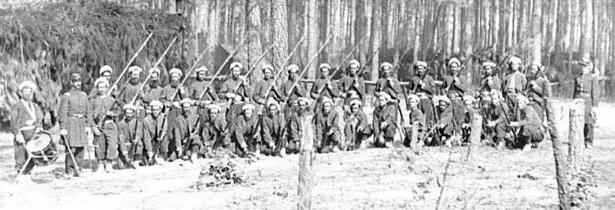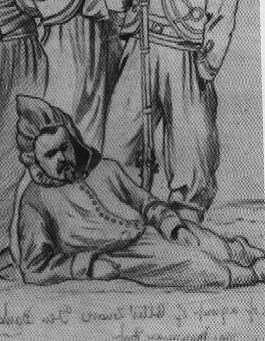

Captain Charles H. T. Collis
This company included many French soldiers who had served as Zouaves in the campaigns of France and who had been identified with the 18th Regiment, in the three months' service. It was recruited at Philadelphia by Charles H. T. Collis, proposing to serve as a bodyguard to Major-Gen. N. P. Banks. The uniform adopted was that of the French Zouaves d'Afrique and was retained by the 114th Regiment, to which it was latter attached, throughout the war.
The corps was mustered in and sent to Fort Delaware on August 17th, 1861, where it was thoroughly drilled in zouave tactics. Late in September the Zouaves reported to Gen. Banks, at Darnestown, Md. After a period of guard duty the corps went into winter quarters. In the spring of 1862 the command served, for a short time, with Geary's Independent Brigade and then rejoined Gen. Banks in the Shenandoah Valley. In a number of battles and skirmishes, including Middletown, Cedar Mountain, second Bull Run, Chantilly and Antietam, the Zouaves had shown those qualities of dash and bravery for which this type of infantry is usually famous. After the affair at Middletown, Capt. Collis was commissioned colonel and detailed to proceed to Philadelphia and recruit his command to a full regiment. With nine fully uniformed companies he arrived at Washington upon August 31st, 1862. The original company in the field, from which many of the officers of the new regiment were selected, became Company A.
Organized at Philadelphia and mustered in August 17, 1861. Moved to Fort Delaware August 17, thence to Frederick, Md., September 25, thence to Darnestown. Attached to Banks' Division, Dept. Shenandoah, September, 1861. Banks' Division, Army Potomac, to March, 1862. Banks' 5th Corps, and Dept. of the Shenandoah, March, 1862. Geary's Independent Brigade to April, 1862. 3rd Brigade, 1st Division, Dept. of the Shenandoah, to June, 1862. Unattached, 2nd Corps, Army Virginia, June, 1862. 3rd Brigade, 1st Division, 2nd Corps, to August, 1862.
SERVICE.--Duty on the Upper Potomac until February, 1862. Moved to Edward's Ferry October 21, 1861, thence to Muddy Branch October 26. Duty there until December 2. At Frederick, Md., until February 22, 1862. Advance on Winchester March 1-12. Occupation of Winchester March 12. March to Warrenton Junction with Abercrombie's Brigade, then with Geary at Rectortown. Rejoined Banks at Strasburg May. Operations in the Shenandoah Valley May 15-June 17. Strasburg May 24. Middletown May 24. Retreat to Williamsport May 24-26. Battle of Winchester May 25. At Williamsport until June 10. Moved to Front Royal, thence to Warrenton and Little Washington June 10-18. Battle of Cedar Mountain August 9. Battle of Antietam September 17(attached to 2nd Mass. Inf. Transferred to 114th Pennsylvania Infantry as Company "A" October-November, 1862.

Colonel Charles H. T. Collis
Total Enrollment: 1,100 Officers and Men
The single company of Zouaves d'Afrique which Capt. Collis had recruited and led to war one year before, formed the basis as Company A of the Zouave regiment raised in Philadelphia in the summer of 1862, and which as the 114th Infantry left the city upon September 1st. At Washington this command was encamped at Fort Slocum, but soon afterward was assigned to the First Brigade, First Division, of the Third Corps, then commanded by Major-Gen. David B. Birney. The Zouaves received their "baptism of fire" on December 13th, when the division was rushed across the Rappahannock river, at Franklin's Crossing, below Fredericksburg, to the assistance of the Pennsylvania Reserves. The loss of the 114th was twelve killed and seventeen wounded.[91] The Third Corps appeared in front of Fredericksburg again in January, 1863 (Burnside's "Mud March"), and a third time at the end of April, at the beginning of the Chancellorsville campaign, crossing the river, however, at United States Ford, about ten miles above the city. In the battle of May 3d the Zouaves fought with heroic persistence, finally retiring with a loss of one hundred and seventy-three killed and wounded. Of the twenty-seven officers present only three escaped death or wounds. Among those killed were Maj. Joseph S. Chandler and Capt. Frank A. Elliott of Co. F. The survivors returned after this bitter experience to camp at Falmouth.
[91] An incident following the battle was the capture of the regimental band of seventeen pieces, with their instruments. The unfortunate musicians were eventually exchanged, and being provided with new instruments, remained with the regiment to the end of the war. (Bates' History, vol. 3, page 1185)
The Third Corps reached Gettysburg after the close of the fighting upon July 1st, and was ordered to the left of the new line of battle, then being extended to the Round Tops. On the morning of the 2d Gen. Sickles advanced a portion of his corps, including the 114th, to and across the Emmittsburg Pike to the right of the Peach Orchard, under the command of Lieut.-Col. Fred. F. Cavada. The Zouaves were a fair mark for the rebel pickets during the morning and for the artillery fire that preceded the infantry attack later in the day. The Confederates surged along the line like a billow sweeping a stormy beach, reaching the front of the 114th when the Zouaves were forced backward, some, including Lieut.-Col. Cavada, in command, being captured. The regiment re-formed under Maj. Edward R. Bowen, took a new position in front of the Taneytown Road, but was not again heavily engaged in the course of the battle. The regimental losses were nine men killed, one officer and eighty-five men wounded, three officers and fifty-seven men captured or missing. Four of the wounded men subsequently died from their injuries. Those captured were near the Sherfy House.
Through the fall and winter of 1863-4 Maj. Bowen continued in command, Col. Collis being in command of the brigade. The regiment shared the fortunes of the Third Corps in its marching and fighting, including battles along the Rappahannock.
In April, 1864, the 114th was honored by selection as the first of six regiments of infantry and one regiment of cavalry organized as an independent brigade for duty at the headquarters of Gen. Meade. Col. Collis was appointed commander of this body of troops. This duty continued until March 15th, 1865, and involved the assistance of other troops in action, while the elite brigade from headquarters was expected to exhibit a high standard of gallantry.
In the final weeks of activity around Petersburg the 114th was engaged in the storming of the Confederate works on April 2d, and, during the pursuit, at Sailor's Creek. At the affair of the 2d, three veteran officers who had originally served in the Zouaves d'Afrique of 1861 lost their lives. They were Capt. A. J. Cunningham, Company A; Maj. Henry M. Eddy[92], and First Lieut. Edward T. Marion, Company I.
[92] Maj. Eddy was commissioned but not mustered.
After the Appomattox surrender the 114th was transferred to the Fifth Corps, with which the Zouaves marched to Washington, where they were mustered out on May 29th, 1865.
TOTAL LOSSES
Killed or died from wounds - 6 officers; 83 men
Died of disease or other causes - 1 officer; 35 men
Wounded, not mortally - 16 officers; 261 men
Captured or missing - 4 officers; 122 men
BATTLES
(Including those of the Zouaves d'Afrique, afterward Company A, prior to
the organization of the regiment)
Middletown, Cedar Mountain, Antietam, Fredericksburg, Chancellorsville,
Gettysburg, Wapping Heights, Auburn, Kelly's Ford, Mine Run, Wilderness,
Guinea's Station, Petersburg
Organized at Philadelphia August, 1862. Left State for Washington, D.C., August 31, 1862. Duty at Fort Slocum, Defenses of Washington, September, 1862. Attached to 1st Brigade, 1st Division, 3rd Army Corps, to March, 1864. Provost Guard, Headquarters Army of the Potomac, to March, 1865. Collins' Independent Brigade, 9th Army Corps, to April, 1865. 1st Brigade, 2nd Division, 5th Army Corps, to May, 1865.
SERVICE.--March up the Potomac to Leesburg, thence to Falmouth, Va., October-November 19, 1862, Battle of Fredericksburg, Va., December 12-15. Burnside's 2nd Campaign, "Mud March," January 20-24, 1863. At Falmouth until April. Chancellorsville Campaign April 27-May 6. Battle of Chancellorsville May 1-5. Gettysburg (Pa.) Campaign June 11-July 24. Battle of Gettysburg July 1-3. Pursuit of Lee July 5-24. Wapping Heights, Va., July 23. Duty on line of the Rappahannock until October. Bristoe Campaign October 9-22. Auburn October 13. Auburn and Bristoe October 14. Advance to line of the Rappahannock November 7-8. Kelly's Ford November 7. Mine Run Campaign November 26-December 2. Payne's Farm November 27. Demonstration on the Rapidan February 6-7, 1864. At Brandy Station until May, 1864. Assigned to duty as Provost Guard at Headquarters Army of the Potomac April 18. Rapidan Campaign May 4-June 12. Battles of the Wilderness May 5-7. Spottsylvania Court House May 8-21. Guinea Station May 21. North Anna River May 23-26. On line of the Pamunkey May 26-28. Totopotomoy May 28-31. Cold Harbor June 1-12. Before Petersburg June 16-18. Siege operations against Petersburg and Richmond June 16, 1864, to April 2, 1865. Garrison and Provost duty at City Point, Va., June 18, 1864, to March 28, 1865. Assault on and fall of Petersburg April 2. Occupation of Petersburg April 3. Moved to Washington, D.C., May 1-12. Grand Review May 23. Mustered out May 29, 1865.
Regiment lost during service 7 Officers and 66 Enlisted men killed and mortally wounded and 1 Officer and 37 Enlisted men by disease. Total 111.